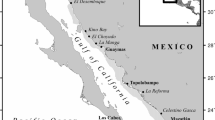Abstract
Timing and sites of parturition of the viviparous scorpionfish Sebastiscus marmoratus were investigated both in aquaria and natural habitats of a rocky coast in southern Japan. Females released 4 mm TL larvae during the early night in winter. Night spawning may be advantageous in avoiding predators of both larvae and spawners, because most such predators are inactive during the night. Females inhabiting shallow areas (< 6 m depth) moved to deeper sites for parturition, but ones inhabiting deeper areas (6–8 m depth) gave birth within their usual habitats. This migration may be advantageous in effective larval dispersal.
Similar content being viewed by others
References cited
Eldridge, M.B., J.A. Whipple, M.J. Bowers, B.M. Jarvis J. Gold. 1991. Reproductive performance of yellowtail rockfish, Sehastes flavidus. Env. Biol. Fish. 30: 91–102.
Fujita, H. M. Kohda. 1996. Male mating effort in the viviparous scorpionfish, Sebastiscus marmoratus. Ichthyol. Res. 43: 247–255.
Fujita, S. 1958. On the egg development and larval stages of a viviparous scorpaenid fish, Sebastes oblongus Günther. Bull. Jap. Soc. Scient. Fish. 24: 475–479 (in Japanese).
Helfman, G.S. 1993. Fish behaviour by day, night and twilight. pp. 479–512. In: T.J. Pitcher (ed.) Behaviour of Teleost Fishes, 2nd ed., Chapman Hall, London.
Johannes, R.E. 1978. Reproductive strategies of coastal marine fishes in the tropics. Env. Biol. Fish. 3: 65–84.
Kohda, M. 1988. Diurnal periodicity of spawning activity of permanently territorial damselfishes (Teleostei: Pomacentridae). Env. Biol. Fish. 21: 91–100.
Kusakari, M. 1995. Studies on the reproductive biology and artificial juvenile production of kurosoi Sebastes schlegeli (Hilgendrof). Scient. Rep. Hokkaido Fish. Exp. St. 47: 41–124 (in Japanese).
Mizue, K. 1959. Studies on a scorpaenous fish Sebastiscus marmoratus Cuvier et Valenciennes—V: on the maturation and the seasonal cycle of the ovaries of the marine ovoviviparous teleost. Bull. Fac. Fish. Nagasaki Univ. 8: 84–110 (in Japanese).
Moser, H.G. 1967. Reproduction and development of Sebastodes paucispinis and comparison with other rock fishes off southern California. Copeia 1967: 773–797.
Robertson, D.R. S.G. Hoffman. 1977. The roles of female mate choice and predation in the mating systems of some tropical labroid fishes. Z. Tierpsychol. 45: 298–320.
Shiokawa, T. 1962. Growth and maturity of the common rockfish, Sebastiscus marmoratus Cuvier et Valenciennes. Rec. Oceanogr. W. Japan. 6: 91–102.
Taylor, M.H. 1984. Lunar synchronization of fish reproduction. Trans. Amer. Fish. Soc. 113: 484–493.
Thresher, R.E. 1984. Reproduction in reef fishes. T.F.H. Publications, Neptune City. 399 pp.
Wourms, J.P. 1991. Reproduction and development of Sebastes in the context of the evolution of piscine viviparity. Env. Biol. Fish. 30: 111–126.
Author information
Authors and Affiliations
Rights and permissions
About this article
Cite this article
Fujita, H., Kohda, M. Timing and sites of parturition of the viviparous scorpionfish, Sebastiscus marmoratus. Environmental Biology of Fishes 52, 225–229 (1998). https://doi.org/10.1023/A:1007471919373
Issue Date:
DOI: https://doi.org/10.1023/A:1007471919373




